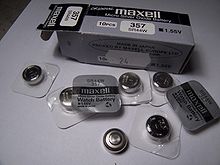Silver oxide battery: Difference between revisions
added photo |
|||
| Line 1: | Line 1: | ||
{{Refimprove|date=May 2008}} |
{{Refimprove|date=May 2008}} |
||
[[Image:silver_oxide_batteries.jpg|thumb|right|Silver oxide battereis]] |
|||
{{Batteries|EtoW=130 Wh/kg<ref name="duracell">{{cite web|url=http://www.duracell.com/Procell/chemistries/silver.asp|title=ProCell Silver Oxide battery chemistry|publisher=[[Duracell]]|accessdate=2009-04-21}}</ref>|EtoS=500 Wh/L<ref name="duracell"/>|EtoCP=Low|PtoW=High|CtoDE=N/A|SDR=Negligible|TD=High|CD=N/A}} |
{{Batteries|EtoW=130 Wh/kg<ref name="duracell">{{cite web|url=http://www.duracell.com/Procell/chemistries/silver.asp|title=ProCell Silver Oxide battery chemistry|publisher=[[Duracell]]|accessdate=2009-04-21}}</ref>|EtoS=500 Wh/L<ref name="duracell"/>|EtoCP=Low|PtoW=High|CtoDE=N/A|SDR=Negligible|TD=High|CD=N/A}} |
||
Revision as of 20:44, 24 March 2010
This article needs additional citations for verification. (May 2008) |

| Specific energy | 130 Wh/kg[1] |
|---|---|
| Energy density | 500 Wh/L[1] |
| Specific power | High |
| Charge/discharge efficiency | N/A |
| Energy/consumer-price | Low |
| Self-discharge rate | Negligible |
| Time durability | High |
| Cycle durability | N/A |
A silver oxide battery (IEC code: S), also known as a silver–zinc battery, is a primary cell (although it may be used as a secondary cell with an open circuit potential of 1.86 volts). Silver oxide batteries have a long life and very high energy/weight ratio, but a prohibitive cost for most applications due to the high price of silver. They are available in either very small sizes as button cells where the amount of silver used is small and not a significant contributor to the overall product costs, or in large custom design batteries where the superior performance characteristics of the silver oxide chemistry outweigh cost considerations. The large cells found some applications with the military, for example in Mark 37 torpedoes or on Alfa class submarines.
Chemistry
A silver oxide battery is a small-sized primary battery using silver oxide as the positive electrode (cathode), zinc as the negative electrode (anode) plus an alkaline electrolyte, usually sodium hydroxide (NaOH) or potassium hydroxide (KOH). The silver is reduced at the cathode from Ag(I) to Ag(s) and the zinc is oxidized from Zn to Zn(II). The chemical reaction that takes place inside the battery is the following:

Zinc is the activator in the negative electrode and corrodes in alkaline solution. When this happens, it becomes difficult to maintain the capacity of the unused battery. The zinc corrosion causes electrolysis in the electrolyte, resulting in the production of hydrogen gas, a rise of inner pressure and expansion of the cell. Mercury has been used in the past to suppress the corrosion, despite its harmful effects on the environment.
Characteristics
Compared to other batteries, a silver oxide battery has a higher open circuit potential than a mercury battery, and a flatter discharge curve than a standard alkaline battery.
It provides up to 40 percent more run time than lithium-ion batteries and also feature a water-based chemistry that is free from the thermal runaway and flammability problems that have plagued the lithium-ion alternatives.[2]
History
This technology had the highest energy density (prior to lithium technologies), and was primarily developed for aircraft use. It was the power source in all of the Apollo spacecraft: the Saturn launch vehicles, command module re-entry batteries, the lunar module and the lunar rover. (The Apollo Service Module used fuel cells as a primary power source.)
This section contains promotional content. |
More recently, the company ZPower has introduced a new line of rechargeable silver-zinc batteries to compete with lithium-ion batteries. The claims include an energy density of 200Wh/kg, complete non-flammability, and no toxic chemicals. To offset the high price of silver, the company plans to offer a trade-in policy to recycle all of it.[3][4] Intel's venture arm, Intel Capital, has provided the company with financial backing.[5] ZPower claimed in 2008 that an undisclosed "major manufacturer" of laptop computers will introduce its silver-zinc battery in a new line of laptops in 2009,[6] with rumors pointing towards Lenovo or Apple Inc. [citation needed]
Recycling
Silver oxide batteries become hazardous when they begin to leak which generally takes a period of five years (which is their normal life) from the time they are put into use. Until recently, all silver oxide batteries contained mercury (around 0.2%). The mercury is incorporated into the zinc anode to inhibit corrosion in the alkaline environment. Sony started producing the first silver oxide batteries without added mercury in 2004.[7]
Most jewelers and watch makers leave these batteries in an open container in their shop, which could lead to health problems for the jewelers. If they do not retain them, they usually discard them in the trash which causes many environmental problems. Once the battery is spent (dead) it needs to be properly handled and recycled by an authorized recycler according to the EPA's Sector of Waste Wise, a program that sponsors correct ways to recycle silver oxide batteries.[8]
References
- ^ a b "ProCell Silver Oxide battery chemistry". Duracell. Retrieved 2009-04-21.
- ^ http://www.eetimes.eu/showArticle.jhtml?articleID=210200401&cid=NL_eeteu
- ^ http://www.edn.com/index.asp?layout=article&articleid=CA6501082
- ^ http://www.edn.com/blog/1470000147/post/1630014763.html
- ^ http://www.edn.com/blog/1470000147/post/1810019781.html
- ^ "ZPower to Demonstrate the First Silver-Zinc Battery for Mobile Electronics at the Intel Developer Forum 2008" (PDF). Retrieved 2008-08-24.
- ^ http://www.azom.com/details.asp?ArticleID=2651
- ^ EPA
